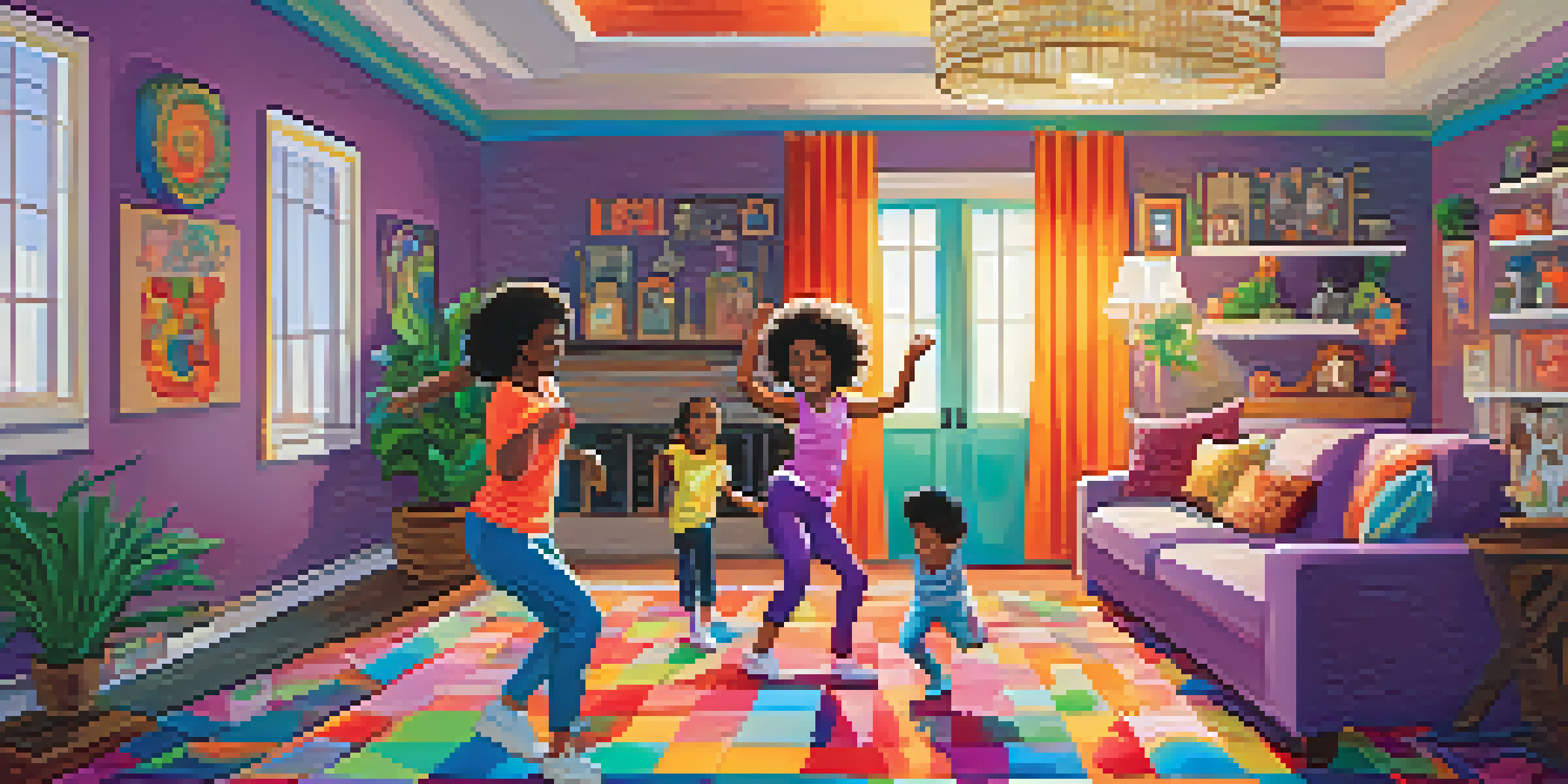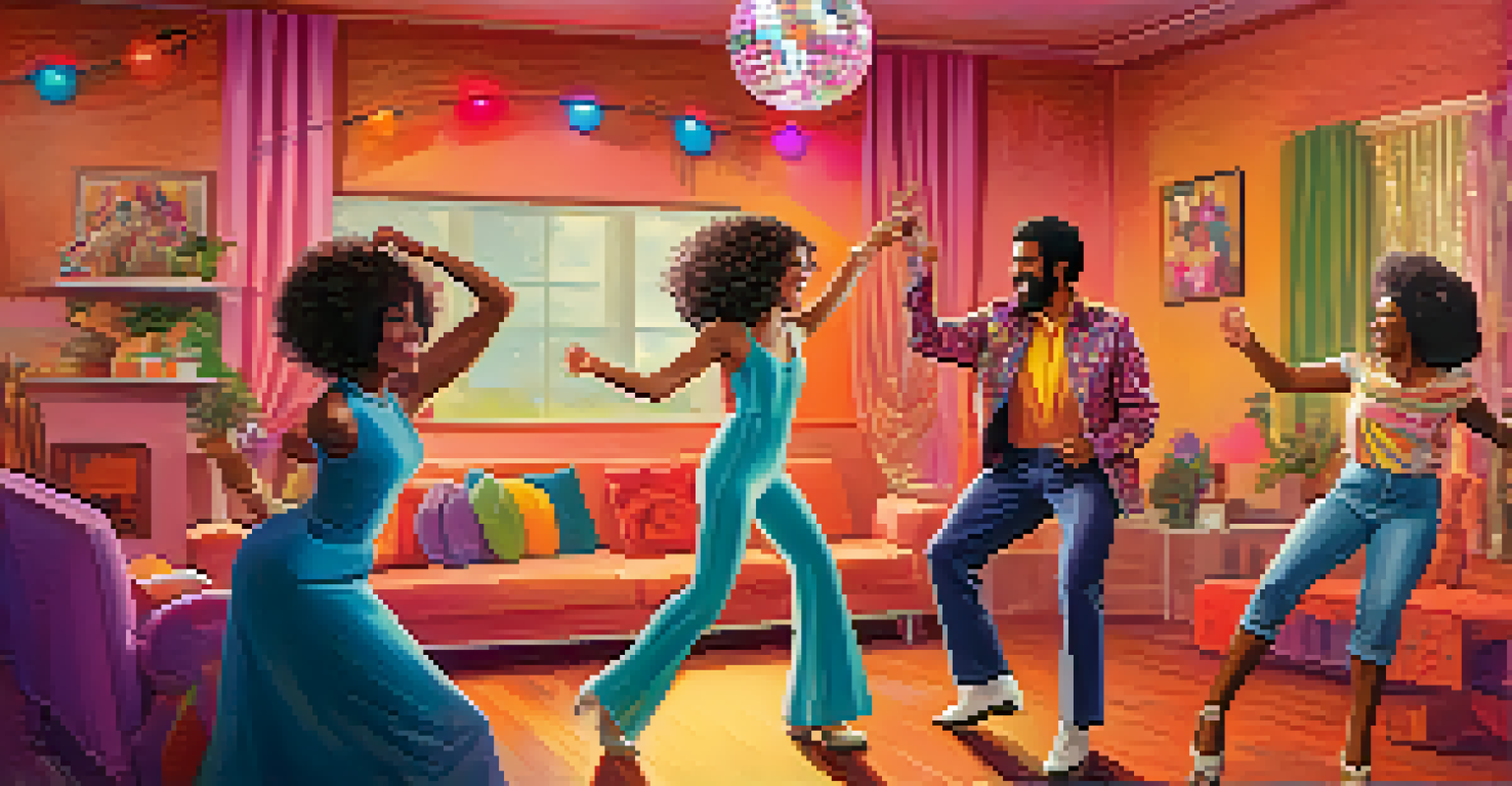Family Dance Nights: Building Bonds Through Movement

The Joy of Dancing Together as a Family
Dancing is a universal language that transcends barriers, making it a perfect activity for families. When you dance together, you're not just moving to the music; you're creating memories and sharing laughter. Each step and twirl helps to build a connection that strengthens family ties and creates a joyful atmosphere at home.
Dance is the hidden language of the soul.
Imagine a living room transformed into a dance floor, with everyone letting loose and enjoying the rhythm. The spontaneity of dance encourages creativity, allowing family members to express themselves freely. This shared experience can be a delightful way to unwind after a long day and reconnect with one another.
Moreover, dance has a way of inviting everyone into the fun, regardless of age or skill level. Whether it's a toddler's clumsy shuffle or a parent's graceful moves, every contribution adds to the collective joy. This inclusivity fosters a sense of belonging, making each family member feel valued and loved.
Creating a Routine: Setting Up Family Dance Nights
Establishing a regular family dance night can bring everyone together, creating a cherished tradition. Choose a day that works for your family—maybe Friday nights or Sunday afternoons—so everyone can look forward to it. Having a set schedule not only builds anticipation but also strengthens your commitment to spending quality time together.

Start by picking a fun playlist that includes everyone's favorites, from classic hits to current chart-toppers. This way, everyone can enjoy the music and feel included in the selection. You might even encourage each family member to take turns being the DJ, giving everyone a chance to share their tastes and introduce new songs.
Family Dance Nights Build Bonds
Dancing together fosters connection and creates cherished memories among family members.
As you establish this routine, it’s important to keep it lighthearted and flexible. The goal is to have fun and connect, so don’t stress about perfecting the moves. Instead, embrace the chaos of dancing together—after all, the best memories often come from unplanned moments.
Benefits of Movement: Physical and Emotional Health
Engaging in dance is not only fun, but it also provides numerous health benefits. Dancing is a fantastic way to get your family moving, promoting physical fitness without the usual monotony of exercise. Whether it's burning calories or improving coordination, family dance nights can contribute to a healthier lifestyle.
Dancing is like dreaming with your feet!
On the emotional side, dancing releases endorphins—those feel-good hormones that boost mood and reduce stress. Sharing this joyful experience can help family members feel more relaxed and connected, strengthening emotional bonds. It’s a simple yet effective way to combat the daily stresses of life together.
Furthermore, dancing can improve communication among family members. As you move together and respond to the rhythm, you learn to communicate non-verbally, enhancing your connection. This exchange fosters a deeper understanding of each other, making it easier to navigate challenges outside of dance night.
Incorporating Variety: Different Dance Styles for Fun
To keep things exciting, consider introducing various dance styles during your family dance nights. From salsa and swing to hip-hop and ballet, exploring different genres can be a fun way to learn together. Each style offers unique movements and rhythms, allowing everyone to discover new favorites.
You can even organize themed dance nights, where each week focuses on a specific style or decade. For example, have a '70s disco night, complete with glitter balls and funky outfits. This not only adds a playful element but also invites family members to engage in some creative planning.
Dancing Enhances Emotional Health
Engaging in dance releases endorphins, boosting mood and reducing stress while strengthening family ties.
By mixing up the dance styles, you can keep everyone on their toes—literally! This variety also opens up opportunities for learning, as family members can teach each other new moves. Dancing in this dynamic way can deepen your connections and create a sense of adventure within your family.
Using Dance as a Tool for Communication
Dance is a powerful form of expression that can help improve communication among family members. As you move together, you're not only sharing a physical experience but also learning to interpret each other's gestures and rhythms. This can lead to deeper emotional connections and a better understanding of one another's feelings.
For instance, if someone feels shy or hesitant, dancing can provide a safe outlet to express themselves without words. Whether it's a dramatic flourish or a silly shimmy, every movement conveys emotion. This can be particularly beneficial for children, who might find it easier to express their feelings through dance rather than verbal communication.
Additionally, using dance to communicate can foster empathy within the family. By understanding each other's non-verbal cues, family members can become more attuned to each other's needs. This heightened awareness can translate into better support and encouragement in everyday life.
Capturing Memories: Documenting Your Dance Nights
One of the best ways to cherish your family dance nights is by documenting them. Capture the laughter, the silly moves, and the smiles through photos or videos. This not only preserves the memories but also serves as a reminder of the fun times spent together as a family.
Consider setting up a designated spot for photos—maybe a fun backdrop or a themed prop area. This can make the experience even more exciting and encourage everyone to get creative with their poses. You might be surprised at the goofy, candid moments that unfold as you dance and capture memories.
Variety Keeps Dance Fun and Engaging
Incorporating different dance styles and themes adds excitement and encourages family members to learn from each other.
Reviewing these memories can also be a wonderful way to reflect on your family's growth and shared experiences. On days when you feel disconnected, revisiting these moments can reignite that joyful spirit. Plus, these keepsakes can be shared with relatives or friends, spreading the joy of your family dance nights.
The Lasting Impact of Family Dance Nights
As you continue to engage in family dance nights, you'll likely notice a positive shift in your family dynamics. The bonds formed through movement create a foundation of trust and openness, allowing family members to feel secure in expressing themselves. This can lead to healthier relationships both within and outside the family unit.
Moreover, the shared joy of dancing together can contribute to a more positive home environment. Families that play together often experience less conflict and increased happiness. This lighthearted atmosphere makes it easier to navigate challenges, knowing you have each other's support.

Ultimately, family dance nights are more than just a fun activity; they are an investment in your family's emotional well-being. By prioritizing these moments of connection, you're building a legacy of love and joy that can be passed down through generations. So, crank up the music and let the dancing begin!